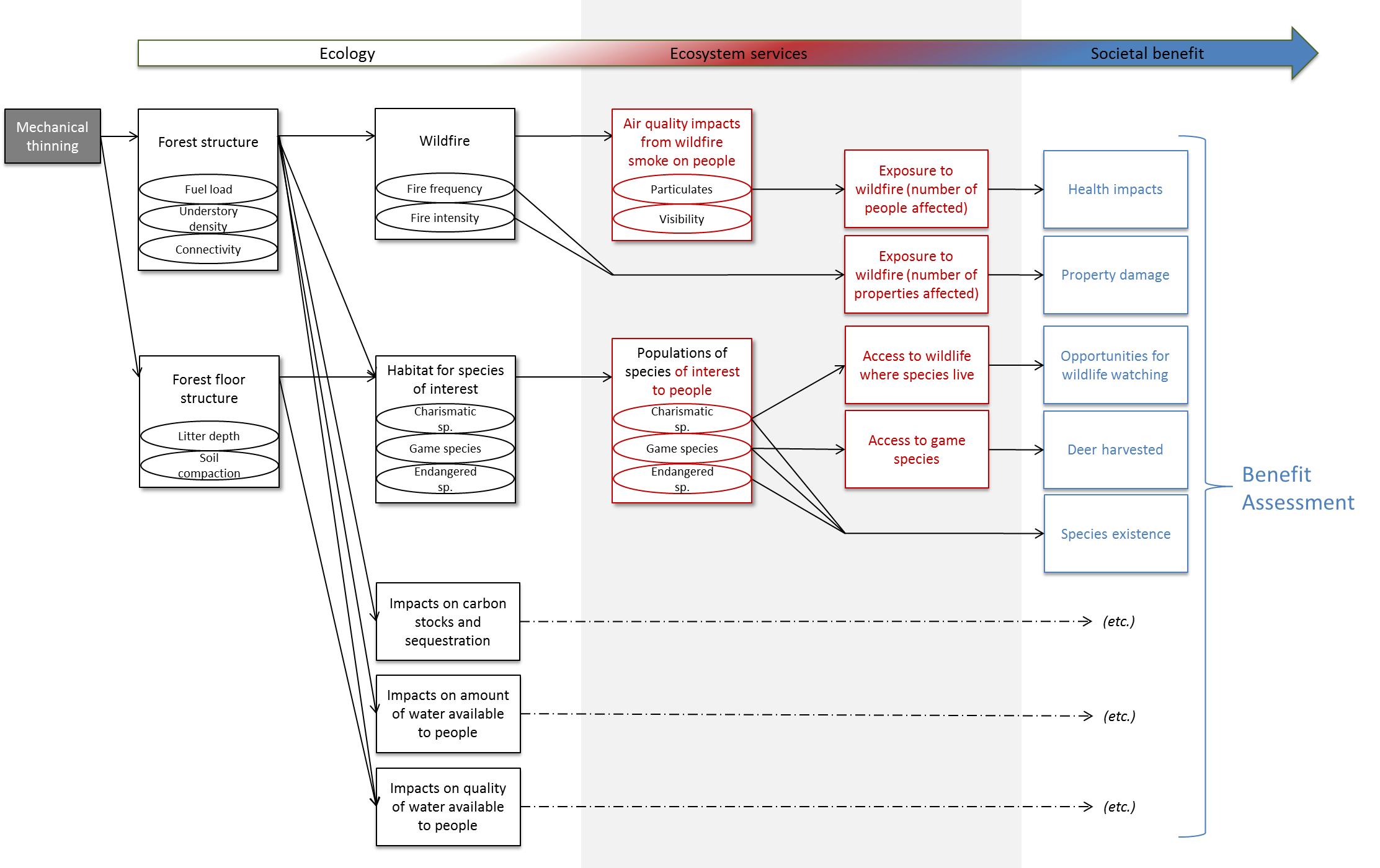Scoping: Identifying Services
This section adapted from excerpts from the paper “Best Practices for Integrating Ecosystem Services into Federal Decision Making.”
Ecosystem services important to a decision process are identified through the process of developing a conceptual diagram that connects policy or management alternatives to the affected ecosystem services and beneficiaries using causal chains. When analyzing changes in ecological conditions brought about by mechanical thinning in a forest, for example, managers can think through how those changes will affect the provision of services and benefits to people (Figure 1). This conceptual mapping process will identify the services important for the decision at hand.
Figure 1. Conceptual map of causal chains indicating possible outcomes of a forest-fire management activity.
Note: Black text indicates an ecological assessment and indicators, red text indicates an extension of an ecosystem services assessment, and blue text indicates measures of social benefit and value.
When developing a conceptual diagram, it might be tempting to refer to a “master list” of services to help ensure no services are inadvertently excluded. Such lists are created in an effort to classify ecosystem services (Box 1).1 Generic lists of services can provide a useful starting point for considering which services and beneficiaries are relevant in a decision context, but given context-specific variation in services, generic classifications will almost always be insufficient and can often be misleading. The reason is the fundamental incapacity of any generic classification to capture context-specific variations that are critical to linkages between ecosystems and human value and that will occur no matter how much effort has been put into development of the classification system. Creating conceptual diagrams using causal chains will reveal location-specific considerations in ways that generic classification cannot.
One reason for development of classification systems is to avoid double counting; some classification systems may be useful in achieving this goal.2 However, double counting can be avoided more effectively using context-specific causal chains (see Building Causal Chains for details).
Box 1. Classification Systems
A number of different systems have been developed and are under development to classify ecosystem services into categories. These systems are intended to increase consistency in use. Decision-specific classification of services may be helpful in some contexts, though they are never essential. The Common International Classification of Ecosystem Services (CICES) is being designed to support incorporation of ecosystem services into national accounts.a National accounts have strict rules about double counting, but the inconsistent ways that ecosystem services are named and distinguished can make it difficult to avoid. The CICES classification, if well designed, will help ensure that the rules of the national accounting decision context are followed. The Environmental Protection Agency is developing two other services classification systems: the Final Ecosystem Goods and Services Classification System (FEGS-CS) and the National Ecosystem Services Classification (NESCS).b Both are intended to enhance consistency across decisions at different scales. Existing classifications should be used with caution and interpreted using context-specific causal chains.
Notes:
a S. Polasky, H. Tallis, and B. Reyers, “Setting the Bar: Standards for Ecosystem Services,” Proceedings of the National Academies of Science of the United States of America 112(24)(2015): 7356–7361; S. Banzhaf and J. Boyd, “The Architecture and Measurement of an Ecosystem Services Index,” Sustainability 4(4)(2012):430–461; J. Boyd, “The Nonmarket Benefits of Nature: What Should Be Counted in Green GDP?,” Ecological Economics 61(4)(2006):716–723.
b European Environment Agency, Common International Classification of Ecosystem Services (2015), http://cices.eu/; D.H. Landers and A.M. Nahlik, Final Ecosystem Goods and Services Classification System (FEGS), EPA/600/R-13/ORD-004914, 2013, http://ecosystemcommons.org/sites/default/files/fegs-cs_final_v_2_8a.pdf; P. Sinha and G. Van Houtven, National Ecosystem Services Classification System (NESCS): Framework Design and Policy Application, draft report prepared for the U.S. Environmental Protection Agency, http://water.epa.gov/learn/confworkshop/upload/FINAL-Summ-WS2-NESCS.pdf.
Footnotes
- 1 Millennium Ecosystem Assessment, Ecosystems and Human Well-Being: Synthesis (Washington, D.C.: Island Press, 2005); European Environment Agency, Common International Classification of Ecosystem Services (2015), http://cices.eu/.; D.H. Landers and A.M. Nahlik, Final Ecosystem Goods and Services Classification System (FEGS), EPA/600/R-13/ORD-004914, 2013, http://ecosystemcommons.org/sites/default/files/fegs-cs_final_v_2_8a.pdf; P. Sinha and G. Van Houtven, National Ecosystem Services Classification System (NESCS): Framework Design and Policy Application, draft report prepared for the U.S. Environmental Protection Agency.
- 2 The Millennium Ecosystem Services Assessment provides a commonly used classification of services. This classification was not generated using a causal chain approach and can result in double counting. Back to reading


